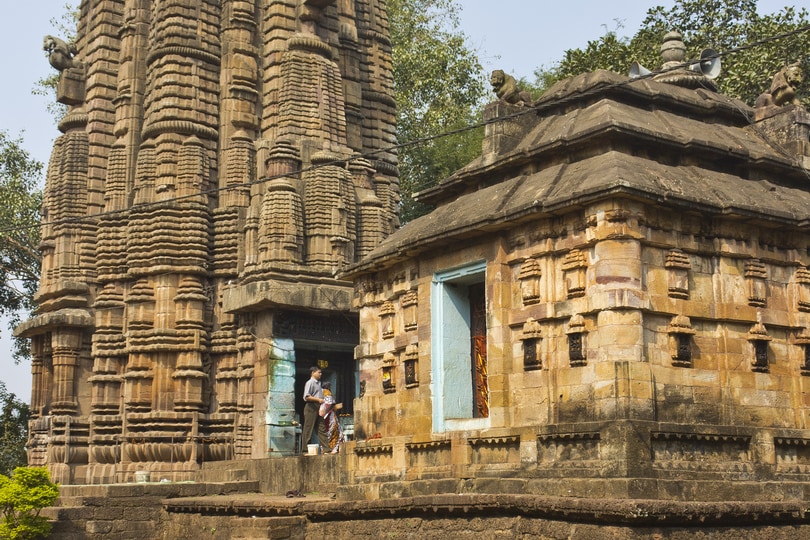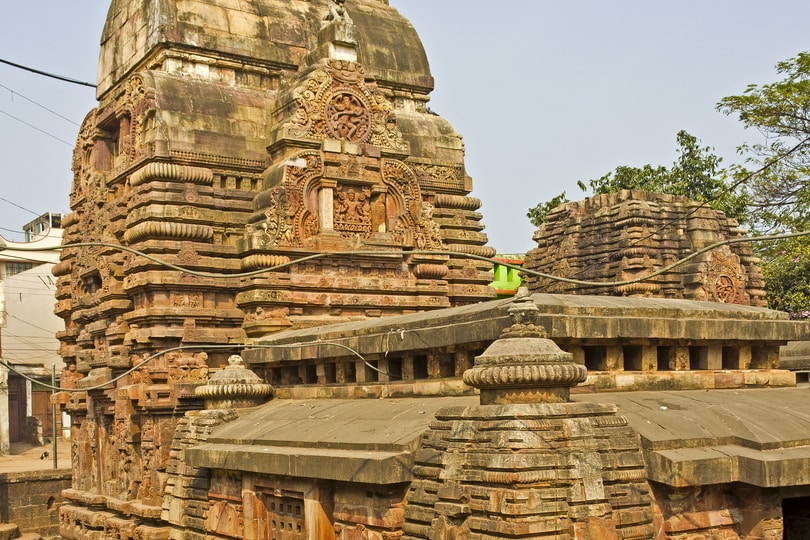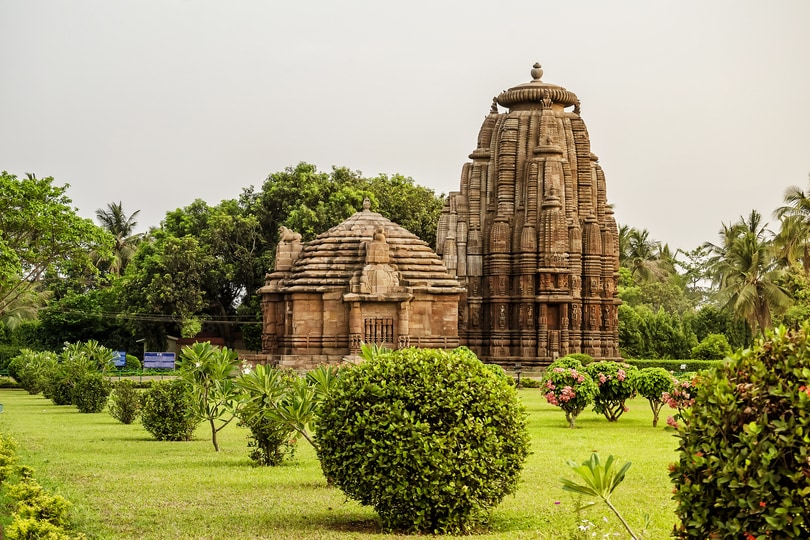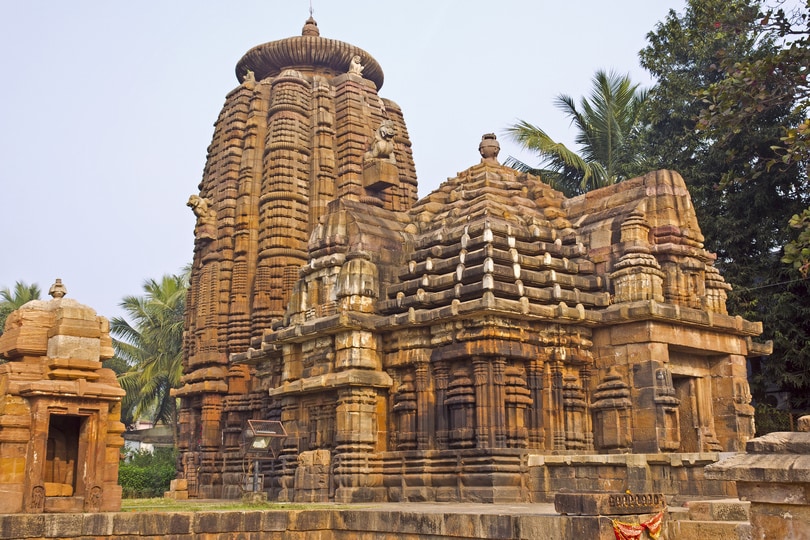It is said that the name Bhubaneshwar comes from the Sanskrit name of Lord Shiva, Tribhuvaneswar, and ancient scriptures refer to this place as Shaiva Pitha. Today, Bhubaneshwar is home to around 700 temples which gives it the name of ‘City of Temples’. While many of these temples belong to Lord Shiva, there are also temples dedicated to Lord Vishnu and temples that show the influences of Buddhism and Jainism.
Find Best Hotels In Bhubaneswar
Lingaraj temple is one of the most famous religious sites in Bhubaneshwar. Constructed in the 11th century, the temple is dedicated to Lord Shiva. People and visitors from across the country visit Lingaraj temple to offer their worship and prayers. Lingaraj temple was built by King Jajti Keshari. The main towers of the temple are 180-feet tall. It was built by using red stone and is a timeless example of the Kalinga style of architecture.
Lingaraj temple is divided into four important sections. First is the Garbh Griha or the sanctum sanctorum, second is the Yajna Shala which means the halls of Yajnas, third is the Bhoga Mandap, meaning the hall of offering, and the fourth and the last is the Natya Shala which is the hall of dance. The temple also has a spacious courtyard and it has 50 small temples that are dedicated to many other Gods and Goddesses of the Hindu religion.
It is also said that soon before the completion of the Lingaraj temple, the Jagannath culture started to flourish in Odhisha.
The temple has a Shiva Linga which is said to have self- originated. The linga is worshipped as Lord Vishnu as well as Lord Shiva. As we have already mentioned that right before the completion of Lingaraj temple, Jagannath culture started to flourish, that’s why the deity in this temple is also called Hari-Hara. While Hari means Lord Vishnu, Hara indicates Lord Shiva.
The shivalinga of this temple is 8 feet tall and has a diameter of 8 feet. Many people from across India visit Lingaraj temple to offer their prayers, and Shivaratri and Rukuna Rath Yatra are said to be the best times to visit Lingaraj temple.
Only Hindus are allowed to visit Lingaraj temple. Towards the north of the temple lies the serene Bindusagar Lake, and this is considered to be one of the best picnic spots. Towards the western banks of the lake, you will see the pristine Ekamravan garden which means one-mango-tree forest. In Hindu mythological texts you will often see the reference of Ekamravan. There are plenty of plants here which are often linked with Hindu Gods and Goddesses. It is said that these plants have medicinal and spiritual significance as well which can be found in Ekamravan.

The Rameshwar temple is a temple that is supposed to have been built sometime in the 12th century AD, during the reign of the Soma dynasty. This temple is also known as the Mausi Maa temple of Lord Lingaraj.
The temple houses a Shiva Linga with a circular ‘yonipitha’. There is also an image of Durga that is worshipped in the sanctum. This is one of the famed religious sites in Bhubaneshwar.
According to local legend, when Lord Ram was returning from Lanka after defeating Ravana, Sita wanted to worship Shiva at this place. Lord Ram built a lingam at the site for her to worship.
The yearly chariot festival of Rukuna Rath Yatra is famous here. This festival, also known as Ashokastami, sees the bronze deities of Chandrasekhar (avatar of Lord Lingaraj), Rukmini and Basudeva being taken to the Rameshwar temple from the Lingaraj temple. A large and colourful procession accompanies this festival.
The deities stay in the temple for four days before being sent back to the Lingaraj temple.
This is another temple dedicated to Lord Shiva and constructed in the 12th century. It is one of the top religious sites in Bhubaneshwar, famous for its ornate sculpture and eye-catching architecture. The temple is decorated with beautiful carvings of birds, flowers, animals, and dancers.
The temple complex also houses two more temples of Bhaskareswar and Brahmeswar which are also famous for their architecture. The Bhaskareswar temple is unique in the entire state because it has nine feet high Shiva Linga enshrined inside it.
The Brahmeswar temple has carvings on the walls which are similar to the Mukteswar temple. There are figures of Lord Shiva and Chamunda with depictions of dancers and musicians on the walls.
Dedicated to Lord Krishna, this 13th-century temple is the only major Vaishnav temple in Bhubaneshwar. Similar to the Jagannath temple in Puri, idols of Lord Krishna, Lord Balram and Subhadra are worshipped here. The difference lies in the build of the deities, as the ones in Puri are made of wood and the ones in the Ananta Basudev temple are made out of granite.
The bhog (prasad) is similar to the Jagannath shrine and Ananta –Basudev temple as both are sold and served within the temple.
Next to the “abhadabhoga” of the Jagannath temple in Odisha, this is the most famous holy meal in Odisha.
Janmashtami is the most important festival here that sees crowds of more than thousands of people.

Vaital Deul is a late 8th century temple dedicated to goddess Chamunda and is among the major religious sites in this city. This temple is also known as Tini Mundia temple. At a walking temple from Lingaraj temple, the Vaital Deul is a famous Shakti temple in the Bhubaneshwar.
Tantrism, sacrifice and eroticism are the practices followed in this temple and the temple is full of carvings of Goddess Durga in her Mahishasura Mardini avatar where she killed the demon Mahishasura.
The presiding deity is adorned with a garland of skulls, seated on a corpse and flanked by a jackal and an owl. She is holding a snake, bow, shield, arrow, thunderbolt, trident and sword. The deity is shown to be piercing the neck of the demon.
There are carvings on the walls of the temple that depict the Sun God, Lord Shiva and Devi Parvati in her avatar of Shakti. There is also a pillar in the inner courtyard where sacrificial offerings were made.
There is another temple in the premises by the name of Sisireswar.
Kedar Gauri Temple is one of the eight Astasambhu (8 Hindu temples dedicated to Lord Shiva) temples in Bhubaneshwar. There are many legends associated with the construction of this temple. One such legend talks about a couple called Kedar and Gauri, who were in love and wanted to marry each other. However, society was against their union and thus they had to flee from their village.
Unfortunately, on the way, Kedar ventured away from Gauri in search of food and was attacked by a tiger which killed him. Hearing this, Gauri jumped into a nearby pond and ended her life. Hearing about this tragic story, the ruling king decided to build a temple at the spot called Kedar Gauri temple.
Dedicated to Lord Kedareshwar (Lord Shiva) and Goddess Gauri, the temple is next door to the Mukteswar temple. There are two ponds in this temple, Khira Kund and Marichi Kund that are said to have sacred powers. The Sitalsasthi festival is the famous occasion in this place and during this, the statue of Lord Lingaraj is brought to the temple of Kedar Gauri so that the marriage between Lord Shiva and Goddess Parvati can take place.
The other attractions of the Kedar Gauri temple include 8-feet tall statues of Hanuman and Goddess Durga.
The Brahmesvara temple is another temple devoted to Lord Shiva and among the eminent religious sites. It is said to have been built in the 9th century A.D. by the rulers of the Somavamsi dynasty. Standing at a height of 60 feet the intricate carvings of nature and gods and goddesses around the temple are sure to capture the attention of any visitor.
There are also images of the guardians of the eight directions, known as dikpalas.
Apart from these, there are depictions of Lord Shiva and other gods in their terrifying avatars. This temple also occupies a unique place in history because historians cite this as the first temple in Odisha to use iron beams in its structure.
There are some inscriptions here which also point towards the prevalence of the Devadasi tradition in the temple whereby beautiful women were presented to the temple to become dancers and spend their life in the service of the temple.
This temple is close to the Lingaraj temple.
The Mukteswar temple is a 9th century architectural marvel that is renowned as a ‘gem of the Kalinga School of temple architecture, and was built in red sandstone. The temple is dedicated to Lord Shiva.
Like most other temples in Bhubaneshwar, it is adorned with ornate carvings of tales from the Panchatantra, female figurines and faces of Buddhist and Jain monks with great details in the carvings which makes them almost life-like. Apart from this, there are beautiful latticed windows on the north and south walls of the temple, depicting scenes of monkeys playing.
However, what stands out in the architecture here is the stone ‘torana’ or archway that dates back to the 900 AD. The archway is a combination of Hindu, Buddhist and Jain themes.
This is one of the most famous temples in Bhubaneshwar and is one of the famed religious sites.

Rajarani temple was built in the 11th century. This temple is also known as the temple of love and Indreshwara temple. It is in Old Bhubaneswar and has beautiful gardens which are properly maintained. The temple got its name from a range of sandstones which was used to build it, particularly the yellow and red sandstone. This temple captures the attention of devotees because of its sculptures and gopuram.
The outer walls of this temple have a number of erotic sculptures of couples. Rajarani will easily remind you of the Khajuraho temple. The architectural beauty of the temple figures and elaborated carvings easily attract a lot of devotees and visitors from all across the country to the temple. You will see also see figures of women looking at a mirror, playing instruments, taking off bracelets and more. These figures are really captivating.
The temple is covered with sculptures of Dikpalas, who are the guardians of the eight directions. You will not see any idol inside the temple, but this temple has a connection with Lord Shiva and Goddess Parvati whose figures can be seen on the doorjambs.
The Rajarani temple is maintained by the Archaeological Survey of India and is located on the Tankapani road. Indian visitors will have to pay Rs 5 for entry, whereas foreign tourists have to pay Rs 100.

Inside the premises of Mukteswar temple lies the peaceful Siddheshwar temple. It was built in the 10th century. As per historians, every temple which was built during the 10th century shows the amalgamation of Buddhist, Hindu, and Jain architecture.
The outer walls of Siddheshwar temple have minimal carvings and this temple is taller than the Mukteswar temple. Although Siddheshwar temple isn’t as popular as Mukteswar temple, it surely does have its own charm.
Once you visit the temple, you will see that it has been built in the Pancharatna style. The temple is surrounded by four lions and has miniature turrets. People come here to worship Lord Shiva, but you will also see a beautiful sculpture of Lord Ganesha, which has become another reason for people to visit Siddheshwar temple.
The figure of Lord Ganesha is always covered with red vermillion and the figure remains in the eastern part of Siddheshwar temple. You will have to cross a magnificent garden to reach Siddheshwar temple.

After visiting Siddheshwar temple, you can head towards Parasurameswar temple which is only a meter away from Mukteswar temple. Although it’s a small temple, it is lavishly decorated. Parasurameswar temple was built during the Sailodbhava period which is during the 7th and 8th century AD. Once you visit the temple, you will notice pine spire along with pyramid covered halls which are the elements of the pre-10th century.
Parasurameswar temple is said to be among the first Hindu structures which have depictions of Kaumari, Sapta-Matrikas-Chamunda, Vaisnavi, Indrani, Varahi, Sivani and Brahmi. You will also see the six-armed Durga image which is one of the earliest representations of Mahisamardini Durga. You will also come across the carving of Lord Shiva in the Natraja pose, in many parts of the temple, along with carvings of Lord Shiva pacifying Ravana, the demon king.
Once you reach the courtyard, you will get to see many miniature versions of Sahasralinga.
The temples in Bhubaneshwar are testimony to the unique temple architecture of Eastern India and age-old traditions that have survived and flourished till date. Tourists and devotees who want to know more about the Hindu, Buddhist and Jain cultures will relish visiting these religious sites.

Please go back to portrait mode for the best experience